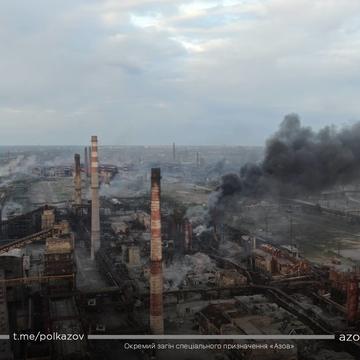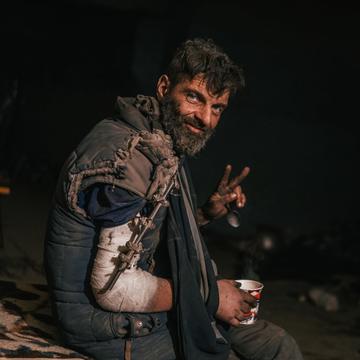May 2022 Blog: The battle for Azovstal and the fate of the Azov regiment
Mariupol, a port city on the Sea of Azov, which used to be home to nearly half a million citizens, is of strategic and symbolic importance to both sides of the Russian-Ukrainian war. For Ukraine, it is an important industrial centre and port that it managed to claw back from pro-Russia separatists back in 2014, when Moscow started the first phase of its war against Ukraine. For Russia, it is a possible land bridge to the annexed Crimea that has proved to be a logistical nightmare and financial burden to run from Moscow. It is also a symbol of Ukrainian resistance and a base of the Ukrainian Azov regiment, which was behind the Ukrainian victory in 2014. The Russian propaganda machine persistently portrays the regiment as far right or neo-Nazi. While, according to experts on far right movements, neither of these descriptions is accurate (more on this below). The defeat of Azov could significantly boost the morale of Russian troops and give the Kremlin something to present at home as a victory.
Azovstal steelworks

Despite its importance for Ukraine, Mariupol was encircled by Russian troops and effectively blockaded within less than a week, which Denys Prokopenko, the Azov regiment commander, attributed to poor resistance of Ukrainian troops against Russians moving in from the Crimea. Nonetheless, Russia’s quick advance did not translate into the quick fall of Mariupol. In fact, although Russia’s Minister of Defence announced that the city was “liberated” on 21 April, it was not surrendered by Ukraine. Led by Azov, Mariupol’s defenders have continued fighting the more powerful adversary until, completely cut off from the rest of the Ukrainian forces, they were forced to retreat to the Azovstal steelworks. Even there the fight did not stop. Alongside the Azov regiment, marines, the police and military medical personnel, the plant provided shelter for hundreds of civilians. The presence of civilians did not deter Russia from continuing using the brutal force, with which it reportedly destroyed over 95% of buildings in Mariupol and killed over 20,000 citizens. Russia continued targeting the plant with the artillery, rockets and missiles, while also attempting to gain access there.
It was only after the visit of the United Nations (UN) Secretary General António Guterres to Moscow and Kyiv that the evacuation, co-organised with the Red Cross, took off. On 7 May 2022, both Russia and Ukraine announced that all elderly people, (civilian) women and children were evacuated from the plant. The same day, President Zelensky confirmed that preparations were under way for phase two of the evacuation that would be aimed at the wounded and medical personnel. While this news was welcomed in Ukraine, it remains to be seen how it can be implemented and what fate awaits the defenders of the city. In the meantime, Russia continues pummelling the plant with all possible means.
The dangerous process of evacuation
The concern about the next phases of evacuation exists not only because a lot of questions remain about the first phase, but also due to the significance, attached to the Azov regiment both in Ukraine and Russia. The major issue with the evacuation, conducted under the aegis of the UN and Red Cross, apart from the fact that Russia repeatedly broke ceasefire, killing three soldiers and wounding six only on one day, was the Russian requirement to take evacuees through filtration camps. After civilians were accompanied out of the Azovstal by Ukrainian soldiers (neither UN nor Red Cross personnel entered the plant), they were escorted by the Russian troops to the filtration camps, where they were strip searched, interrogated, had their belongings inspected and messages on mobile phones read. Those, suspected of having links to the Ukrainian military or being Ukrainian “nationalists” were detained. One indication of this is the discrepancy in the number of those evacuated. Previously, it was reported that up to 1,000 civilians were sheltering at the plant, but according to Zelensky only 300 reached Zaporizhzhia, which remains under Ukrainian control. Even if we accept that initial estimates were inaccurate or some civilians went to Russia (which according to the Ukrainian government should be treated as a deportation), we are still left with witness accounts of those, whose relatives were held behind in the camps. One of the most distressing examples is that of a 4-year old girl Alisa who reached Zaporizhzhia by herself, while her medic mother remained in the camp. This is the same girl, whose face appeared on the t-shirts of Donetsk Shakhtar football club after a video of her in an Azovtsal bunker went viral. The fate of her mother remains unknown.
The Azov Regiment: its past and future
While it is impossible to estimate the number of civilians who were kept in filtration camps as they were trying to reach the Ukrainian controlled territory after leaving Azovstal or Mariupol in general, there is little hope that any of the wounded, medical personnel or the Ukrainian military will be allowed to leave these camps at all. The Azov regiment was set up in May 2014 as a volunteer battalion. Some of the original members were football ultras, others - members of the far-right organisation “Patriots of Ukraine”. However, already in the autumn of 2014 the battalion became a regiment under command of the National Guard of Ukraine, part of the Ministry of Internal Affairs. This was followed by the process of depoliticization as the fighters with far-right views left and formed an NGO Civil Corps of Azov, which transformed into a political party National Corps. This party did not attract enough votes to enter the Parliament, while the regiment itself developed into an elite military structure, without allegiance to any political movement. Today, the Azov regiment includes Ukrainians, Russians, Jews, Greeks, Georgians, Belarusians and Crimean Tartars. Most of the soldiers are Russian speakers, and what is more, they defend the predominantly Russian speaking city of Mariupol.
At the same time, these soldiers are devoted to Ukraine and serve to protect their country’s territorial integrity, which is enough for Russia to continue branding them as “neo-Nazis”. Eight years of Russian portrayal of the Azov as “fascists” is difficult to shrug off. The media continue referring to them as a “far-right battalion”, which is one reason why the Azov pleas for help, often aimed at the international community, continue falling on deaf ears. In my opinion, allowing Azov soldiers to be ruthlessly exterminated by Russia will be a big mistake for at least two reasons. First, they are valuable as witnesses of the war crimes committed in Mariupol. After the world saw the atrocities, committed in Bucha, Mariupol authorities claimed that the situation in the city was likely to be much worse. This led Russian troops to start collecting dead bodies from the streets and digging them out from mass graves to burn in mobile crematoriums. In preparation for the celebrations of May 9th, Russians also cleared the debris at the Drama Theatre, where investigative journalists estimate around 600 were killed by a Russian strike. The longer Russian troops stay in the city, the less evidence of their crimes will be preserved. The testimony of the Azov regiment will therefore be priceless.

For similar reasons, Russians are more interested in killing the defenders of Mariupol rather than taking them captive. Surrender is not an option in such circumstances. On the other hand (and this is the second reason why more needs to be done to save Azov), if the regiment is destroyed, this almost certainly will have negative consequences for the Ukrainian government and the united front it had conjured up at home and abroad. For most in Ukraine, the Azov regiment are heroes, and their death could significantly weaken Zelensky, who himself was highly critical of how his predecessor Petro Poroshenko handled big battles in the Donbas in 2014-2015. So how can the Azov be helped?
According to the Ukrainian government, the military solution is not an option right now as it would take too much time and heavy weaponry, which Ukraine is still missing. At the same time, Azov soldiers do not dismiss this variant. The political solution that has been discussed as most practical is the evacuation via a third party, preferably an international government or coalition, which could organise a passage to safety, something akin to the Operation Dynamo in Dunkirk in 1940. The intermediary, however, will need to take on a more proactive role than did the UN and Red Cross. With Russia increasing its pressure on Azovstal (e.g. on 10 May alone, the plant reportedly endured 38 airstrikes) and rumours about the possible use of chemical weapons resurfacing, there is an urgent need for decisive action, which I believe will have a better chance to succeed if it combines both diplomatic and military dimensions.
Dr Anastasiia Kudlenko
OBO Research Fellow, University of Oxford
